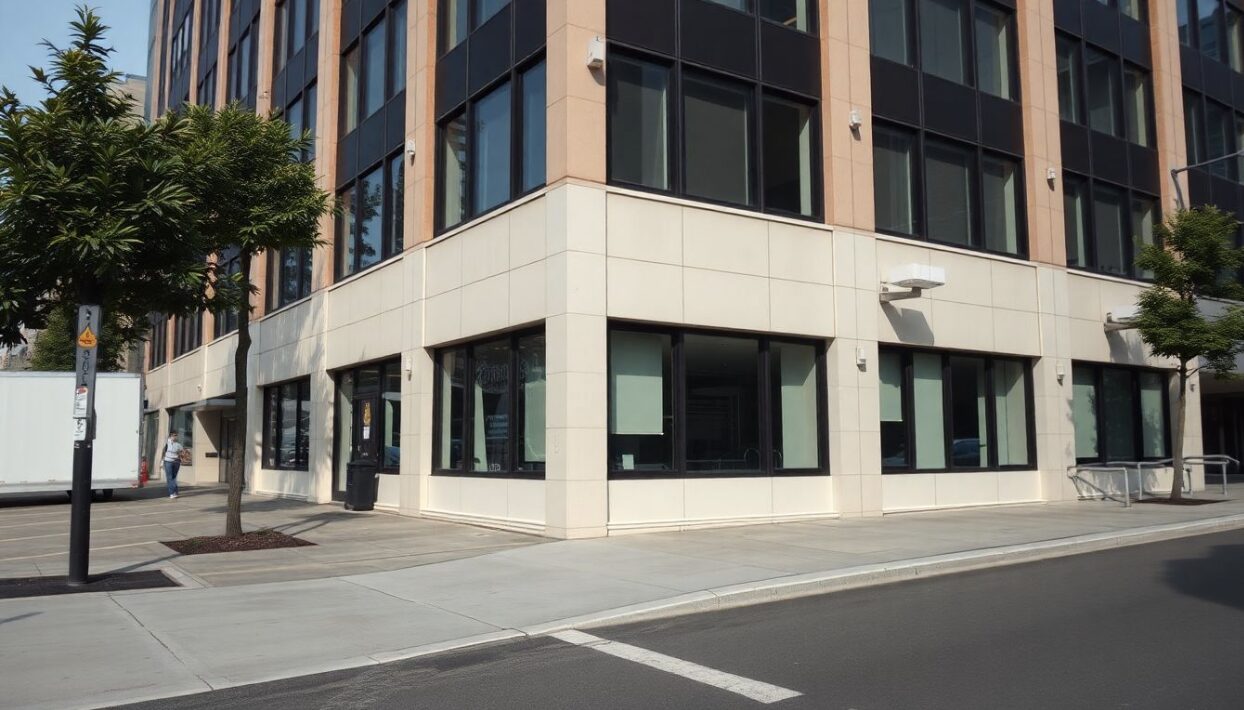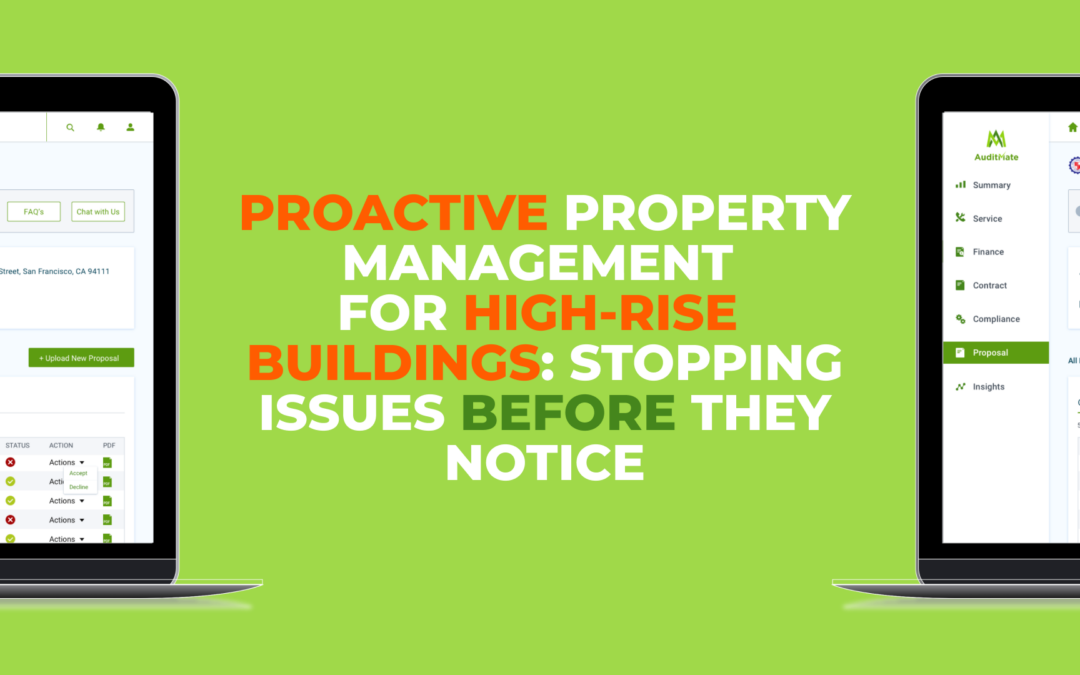Managing high-rise buildings is tough. One fact stands out – regular care keeps these giants safe and valuable. This article shows how to spot problems early, fix them fast, and plan smartly.
Keep reading for key insights.
The Importance of Proactive Property Management
Proactive property management makes a building last longer, keeps everyone safe, and tenants happy. It cuts down costs and encourages people to stay. Quick fixes stop big problems and save money in the long run.
A well-cared-for building can ask for higher rent or sell for more money. Happy tenants stay longer, which means less work finding new ones.
A stitch in time saves nine.
Using smart tools helps spot problems early—like elevator issues before they break down. These tools use data to plan upkeep better and keep everything running smoothly. This way, buildings don’t have sudden big repairs, which saves lots of money over time.
Keeping an eye on signs like wear or odd utility use can prevent trouble before it starts.
Early Warning Signs of Potential Issues
Spotting problems early in high-rise buildings can save a lot of trouble. Look out for signs like cracks or leaks that tell you something’s wrong. Seeing your energy bills go up? This could be a clue too.
Don’t overlook what tenants say – their complaints often point to bigger issues.
Taking steps ahead of time keeps buildings in top shape. Regular checks catch problems before they grow. Making sure everything is ready for the change of seasons is key, as is fixing small things fast.
Using tech helps plan maintenance better. Tools that predict when something will need work can save time and money.
Choosing the right time for repairs means less hassle for everyone. A schedule helps focus on what needs attention first, making sure nothing gets missed.
This approach keeps high-rise buildings safe and sound, avoiding big fixes later by dealing with little issues now.

Structural wear and tear
Buildings face structural wear and tear over time. Cracks, corrosion, and water coming in show there are problems. These signs point to big issues ahead if not fixed early. Maintenance teams must keep an eye out for these warnings.
They need to check the building often to catch problems fast.
For high-rise buildings, keeping everything working well is key. This includes elevator maintenance. Small fixes now can stop big repairs later. Teams use logs to track all issues they find.
This helps them see patterns and decide what to fix first.
Predictive maintenance tools come in handy here too. They use data to tell when something might go wrong before it does—this way, fixing things happens on a schedule that stops bigger problems later on.
Unusual utility usage patterns
Increases in water or electricity consumption often indicate an issue in tall buildings. These abnormal patterns can suggest leaks, electrical malfunctions, or other problems that might not yet be apparent.
Noticing these signs aids in preventing larger complications from developing.
Proactive property management heavily relies on observing changes in utility usage.
IoT devices become significant in this context. They monitor utility consumption in real-time and swiftly alert of any unusual patterns. This enables building owners to respond rapidly, rectifying minor problems before they escalate into expensive repairs.
Utilizing data from these intelligent technologies renders maintenance schedules more efficient and saves money over time by averting hefty repairs.
Tenant complaints and feedback
Tenant complaints often point to bigger issues in high-rise buildings. Common concerns include maintenance problems, aging appliances, and rising utility costs. These complaints are key signs for property managers to act fast.
Quick response times show tenants they matter. Updating appliances between residents cuts down on complaints.
Listening to feedback helps manage utility costs better too. Effective communication solves many tenant concerns quickly, boosting satisfaction. Keeping tenants happy means fewer problems and more stable management of the high-rise building.

Preventive Actions for High-rise Buildings
Taking care of high-rise buildings means acting early, before problems grow big. It’s like being a detective, always on the lookout for clues. Small signs can tell us big stories about what’s going wrong inside these towering structures.
In managing such buildings, spotting issues early is key. Think about a crack in the wall or water that doesn’t drain right. These might seem small, but they’re like early warning alarms.
Unusual changes in how much water or electricity people use can also give hints of leaks or other hidden problems.
Listening to those who live and work in these buildings helps too. When tenants say something’s not right, it pays to listen closely and check it out fast.
The next step? Taking action before these whispers turn into shouts. Regular checks and keeping up with maintenance as seasons change keep everything running smoothly without surprise breakdowns.
Fixing little things straight away stops bigger headaches later on—like patching up a leak before it ruins a whole floor.
Predictive maintenance tools
Regular inspections and assessments
Regular inspections play a big role in keeping high-rise buildings safe and comfy. They spot problems like structural damage and fire risks early.
- Inspectors look at the building’s structure to find any signs of wear and tear. This keeps the building strong.
- They check fire safety tools to make sure everything works right. This helps everyone stay safe.
- The team looks for leaks or water damage. Fixing these issues early prevents bigger problems.
- Inspections also include making sure all exits are clear and safe to use during an emergency.
- Teams test building systems like heating and cooling to keep rooms comfortable.
- They review how well the building follows codes and rules. Staying in line with these rules is key.
- Looking at past inspection reports helps find issues that need more attention.
Next, the focus shifts to scheduling seasonal maintenance to keep everything running smoothly.
Scheduling seasonal maintenance
After checking on regular inspections, it’s key to plan for seasonal maintenance. This step keeps high-rise buildings in top shape and avoids bigger problems.
- Seasonal maintenance is a must for the HVAC system. It keeps the air clean and temperature right.
- Before winter hits, check the heating system. Make sure it can warm the building well.
- In spring, inspect roofs and windows for leaks from snow or rain.
- Clean gutters and drains before heavy rains start. This prevents water damage.
- Swap out filters in the HVAC system as seasons change. It helps air flow better.
- Check all safety gear before harsh weather comes. This includes things like fire extinguishers and alarms.
- Look at the building’s outside walls for cracks or signs of wear. Fix them right away to avoid big repairs later.
- Keep records of all this work. They are important if you need to talk to insurance or fix something big.
This way, high-rise buildings stay safe and comfy for everyone inside.
Addressing minor repairs immediately
Fixing small problems fast keeps high-rise buildings safe and clean. Broken things should get repaired right away. This stops bigger issues from happening later. Also, it is important to keep shared places clean and remove trash well.
Taking care of these tasks shows good property management. It helps avoid unexpected repairs that can cost a lot of money and time. Building owners find this approach helpful in keeping their properties in top shape without breaking the bank.
Leveraging Predictive Maintenance Tools
In a world where high-rise buildings touch the sky, proactive property management acts as the backbone of a sturdy structure. It’s about stopping issues before they even become noticeable.
Understanding the importance of this approach can change how building owners and facility executives view maintenance. It’s not just fixing what’s broken; it’s about preventing problems from occurring in the first place.
Early warning signs like structural wear and tear signal that a building needs care. If walls could talk, cracks and creaks would tell tales of the need for inspection. When utility bills start to look odd—too high or too low—it’s another clue that something’s off.
Listening to tenant complaints gives insight into smaller issues that could balloon into larger ones if ignored.
Preventive actions come next, setting a solid plan in motion. Routine checks keep an eye on everything from foundations to rooftop vents. With seasons changing, maintenance doesn’t sleep—winter proofing in fall and cooling systems checks before summer hits are key steps.
And when.
Benefits of data-driven maintenance scheduling
Data-driven maintenance scheduling cuts down on high repair costs. This approach uses AI and machine learning to find patterns and problems early on. It helps building owners fix things before they get worse.
Such smart planning saves a lot of money compared to waiting for things to break.
Data-driven decisions prevent small issues from becoming big, expensive ones.
This way of scheduling also makes maintenance teams more efficient. They can tackle the most important tasks first in high rise buildings. Taking care of these priorities ensures that buildings stay in top shape over time.
Next up, let’s explore how IoT and smart building technology play a role in this process.
Role of IoT and smart building technology
IoT and smart building technology play a big role in keeping high-rise buildings safe and working well. These tools use smart lighting, HVAC systems, and security to watch over the building every day.
They catch problems early. This means less downtime and saves money.
Predictive maintenance uses data to plan checks and fix things before they break. This makes everything run smoother. Now, let’s talk about how timing service can make things even better.
Timing Service Interventions for Maximum Efficiency
Timing service interventions right saves time and money. By planning, building owners catch problems early, avoid big repairs, and keep buildings safe and comfortable for everyone.
Developing a maintenance calendar
Making a maintenance calendar helps keep buildings working well. It stops machines from breaking down and makes assets last longer. A tool called FirstService Residential Connect can help with this.
It sends out reminders and updates for when it’s time to fix things.
This tool uses a current reserve study. This study shows when to fix or replace building parts. By following this schedule, buildings stay in good shape. Next, we focus on which areas need the most attention first.
Prioritizing high-risk areas
After setting up a maintenance calendar, building owners must focus on high-risk areas. These spots need immediate care to prevent safety hazards or structural damage. They also need to follow laws to avoid fines and keep tenants safe.
Cost is important too. Owners have to choose repairs that fit their budget but still fix big problems.
They first look at parts of the building used a lot, like elevators and stairs. Next, they check systems critical for safety, like fire alarms and sprinklers. If these fail, it could be very dangerous.
So, they fix any issues right away before they grow into bigger problems. This way, the building stays safe and costs stay low.
Conclusion
Proactive property management makes high-rise buildings better. It stops problems before they grow big. Early signs like cracks or high water use tell owners when to fix things early.
Regular checks and fixing small issues keep buildings safe and save money in the long run. Using smart tools helps plan repairs at the best time, making everything more efficient. This way keeps buildings good for longer, makes people happy, and saves cash.
FAQs
1. What is proactive property management for high-rise buildings?
Proactive property management is a strategy that focuses on stopping issues in high-rise buildings before they become noticeable problems.
2. How does proactive property management work?
This approach involves regular maintenance checks, immediate response to potential concerns, and ongoing improvements to ensure the building remains in top condition and prevent any possible issues from escalating.
3. Why should I consider proactive property management for my high-rise building?
Being proactive means you’re always one step ahead of any problem. It not only saves you from costly repairs but also ensures tenant satisfaction by keeping their living conditions at its best.
4. Can anyone implement a proactive property management strategy?
Absolutely! Anyone involved in managing a high-rise building can adopt this approach — it just requires careful planning, attention to detail, and commitment to continuous improvement.

